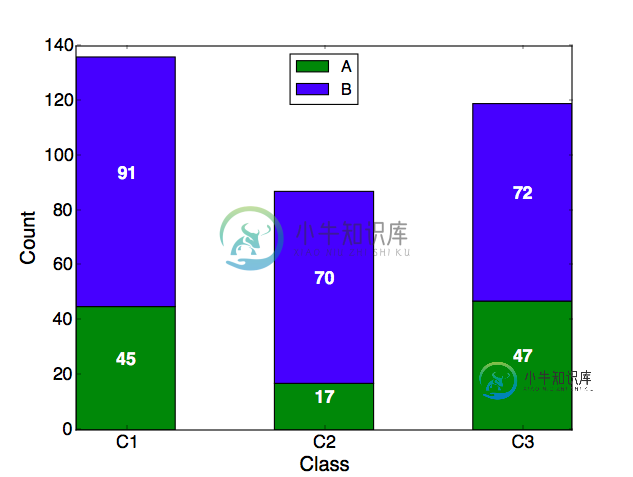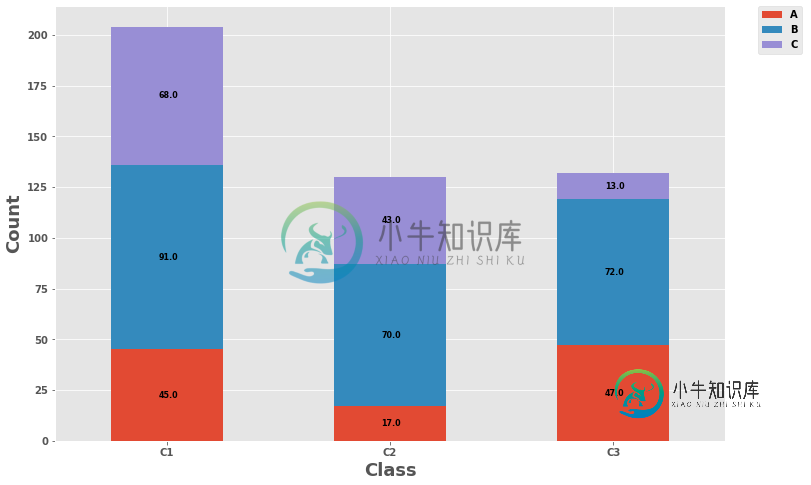带居中标签的堆叠条形图
我试图在堆叠条形图中“稳健地”居中数据标签。下面给出了一个简单的代码示例和结果。如您所见,数据标签并不是在所有矩形中都居中。我错过了什么?
import numpy as np
import matplotlib.pyplot as plt
A = [45, 17, 47]
B = [91, 70, 72]
fig = plt.figure(facecolor="white")
ax = fig.add_subplot(1, 1, 1)
bar_width = 0.5
bar_l = np.arange(1, 4)
tick_pos = [i + (bar_width / 2) for i in bar_l]
ax1 = ax.bar(bar_l, A, width=bar_width, label="A", color="green")
ax2 = ax.bar(bar_l, B, bottom=A, width=bar_width, label="B", color="blue")
ax.set_ylabel("Count", fontsize=18)
ax.set_xlabel("Class", fontsize=18)
ax.legend(loc="best")
plt.xticks(tick_pos, ["C1", "C2", "C3"], fontsize=16)
plt.yticks(fontsize=16)
for r1, r2 in zip(ax1, ax2):
h1 = r1.get_height()
h2 = r2.get_height()
plt.text(r1.get_x() + r1.get_width() / 2., h1 / 2., "%d" % h1, ha="center", va="bottom", color="white", fontsize=16, fontweight="bold")
plt.text(r2.get_x() + r2.get_width() / 2., h1 + h2 / 2., "%d" % h2, ha="center", va="bottom", color="white", fontsize=16, fontweight="bold")
plt.show()

共有1个答案
- 以下方法更简洁,易于缩放。
- 将数据放入
熊猫中。数据帧是绘制堆叠条形图的最简单方法。 - 使用
pandas.DataFrame.plot.bar(堆叠=真)或熊猫。数据帧(种类='条形',堆叠=真)是绘制堆叠条形图的最简单方法。- 此方法返回一个
matplotlib.axes.Axes或它们的一个 numpy.ndarray。
import pandas as pd import matplotlib.pyplot as plt A = [45, 17, 47] B = [91, 70, 72] C = [68, 43, 13] # pandas dataframe df = pd.DataFrame(data={'A': A, 'B': B, 'C': C}) df.index = ['C1', 'C2', 'C3'] A B C C1 45 91 68 C2 17 70 43 C3 47 72 13-
< li >使用< code > matplotlib . py plot . bar _ label ,它会自动将值放在条形的中央。 < li >有关< code >的更多详细信息和示例,请参阅如何在条形图上添加数值标签。条形标签。 < li >使用< code>pandas v1.2.4进行测试,该版本使用< code>matplotlib作为绘图引擎。 < li >如果条形图的某些部分为零,请参见我的回答,其中显示了如何为< code >自定义< code >标签。bar_label()。 < li>
ax.bar_label(c,fmt='%0.0f ',label_type='center')会根据需要更改数字格式以不显示小数位。ax = df.plot(kind='bar', stacked=True, figsize=(8, 6), rot=0, xlabel='Class', ylabel='Count') for c in ax.containers: # Optional: if the segment is small or 0, customize the labels labels = [v.get_height() if v.get_height() > 0 else '' for v in c] # remove the labels parameter if it's not needed for customized labels ax.bar_label(c, labels=labels, label_type='center')
seborn是matplotlib的高级api
seaborn.barplotapi没有堆叠选项,但它可以用sns.histplot或sns.displot实现。
# create the data frame df = pd.DataFrame(data={'A': A, 'B': B, 'C': C, 'cat': ['C1', 'C2', 'C3']}) A B C cat 0 45 91 68 C1 1 17 70 43 C2 2 47 72 13 C3 # convert the dataframe to a long form df = df.melt(id_vars='cat') cat variable value 0 C1 A 45 1 C2 A 17 2 C3 A 47 3 C1 B 91 4 C2 B 70 5 C3 B 72 6 C1 C 68 7 C2 C 43 8 C3 C 13# plot ax = sns.histplot(data=df, x='cat', hue='variable', weights='value', discrete=True, multiple='stack') # iterate through each container for c in ax.containers: # Optional: if the segment is small or 0, customize the labels labels = [v.get_height() if v.get_height() > 0 else '' for v in c] # remove the labels parameter if it's not needed for customized labels ax.bar_label(c, labels=labels, label_type='center')
# plot g = sns.displot(data=df, x='cat', hue='variable', weights='value', discrete=True, multiple='stack') # iterate through each axes for ax in g.axes.flat: # iterate through each container for c in ax.containers: # Optional: if the segment is small or 0, customize the labels labels = [v.get_height() if v.get_height() > 0 else '' for v in c] # remove the labels parameter if it's not needed for customized labels ax.bar_label(c, labels=labels, label_type='center')
- 使用
. patches方法解压matplotlib.patches.Rectangle对象的列表,堆叠条的每个部分一个。- 每个
。矩形有提取定义矩形的各种值的方法。 - 每个
。矩形是从左到右,从下到上的顺序,所以所有的。矩形对象,对于每个级别,在遍历时按顺序显示。补丁。
label_text=f“{高度:0.0f}”将显示不带小数位数的数字
plt.style.use('ggplot') ax = df.plot(stacked=True, kind='bar', figsize=(12, 8), rot='horizontal') # .patches is everything inside of the chart for rect in ax.patches: # Find where everything is located height = rect.get_height() width = rect.get_width() x = rect.get_x() y = rect.get_y() # The height of the bar is the data value and can be used as the label label_text = f'{height}' # f'{height:.2f}' to format decimal values # ax.text(x, y, text) label_x = x + width / 2 label_y = y + height / 2 # plot only when height is greater than specified value if height > 0: ax.text(label_x, label_y, label_text, ha='center', va='center', fontsize=8) ax.legend(bbox_to_anchor=(1.05, 1), loc='upper left', borderaxespad=0.) ax.set_ylabel("Count", fontsize=18) ax.set_xlabel("Class", fontsize=18) plt.show()
-
< li >要绘制水平条: < ul > < Li > < code > kind = ' barh ' < Li > < code > label _ text = f“{ width }” < li>
如果宽度 - 每个
- 此方法返回一个
-
问题内容: 我试图在一个堆积条形图中“稳健地”居中数据标签。A下面给出了简单的代码和结果。如您所见,数据标签并不是所有的矩形都居中。我错过了什么? 问题答案: 你为什么写“va=”bottom“。
-
我用AndroidPlot在堆叠条形图上有3个数据系列。例如: 在我的图表中,我有3个刻度。例如,标签中显示的值是从序列1 min 1到序列1 max 5,这是序列1的最大值。事实上,总的虚设范围将是 所以我必须展示的标签将从最小5到最大15 知道如何解决这个问题吗?
-
我有以下不同月份的数据 一月:[1,5,3] Feb:[10,5] 三月:[4,8] 四月:[7] 可能:[3,1,5,0,7] 我想生成如下所示的条形图 现在,我有以下代码,我想知道如何生成如上图所示的条形图。 }); 非常感谢。
-
Highcharts 条形图 以下实例演示了堆叠条形图。 我们在前面的章节已经了解了 Highcharts 基本配置语法。接下来让我们来看下其他的配置。 配置 plotOptions 配置图表堆叠使用 plotOptions.series.stacking,并设置为 "normal"。如果禁用堆叠可设置为 null , "normal" 通过值设置堆叠, "percent" 堆叠则按百分比。 v
-
我需要一张这样的图表: 我找到了这个示例,但它使用了旧版本的。我尝试使用v2.0,但我不明白。 有人能贴个例子吗?
-
我想要一张堆叠的条形图,那里有一条阈值线。阈值线以上的条色应为红色,阈值线以下的条色应为绿色。问题是,阈值不是恒定的,对于每个x值,它可能有不同的值。我想随时更新这个阈值,以获得某个x值。如何做到这一点?很明显,柱状图的y参数应该是动态的,也许我应该为它们传递一个函数?请帮我做这个。我也认为阈值应该是一个函数,因为我会更新它

